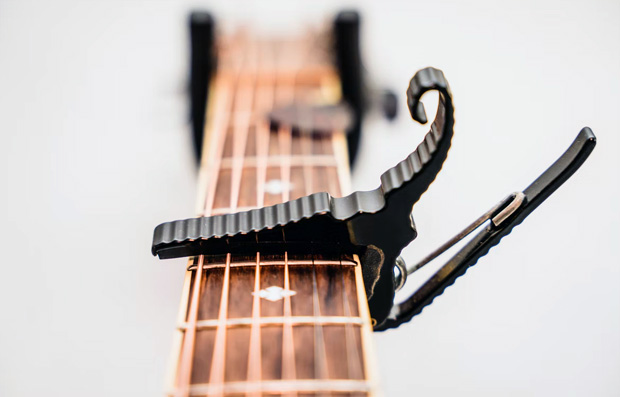A Comprehensive Guide to The Guitar Capo

A Comprehensive Guide to The Guitar Capo
The term can be said in a variety of ways. “Capo” is an abbreviation for “capodastro” or “capotasto,” which is an Italian term meaning “head of the neck.”
A capo is a tiny device that clips onto the guitar neck and shortens the length of the strings. You can use this instrument on various string instruments, not only guitars. Capos can be used on mandolins, mandolas, banjos, acoustic guitars, and bouzoukis, among other fretted instruments.
Capos have been present for centuries, with Giovanni Batista Doni, an Italian musicologist and humanist, the first to employ them in 1640. James Ashborn of Wolcottville, Connecticut, patented the device for the first time in 1850.
How Does the Capo Work?
Understanding the role of a nut on a guitar is essential to completely comprehending how a capo works. Where the fretboard joins the headstock is where the nut is found. It’s a thin strip, usually made of plastic, with grooves for each string to be put and guided correctly down the neck. The strings are then fastened around the tuning keys.
In the sense that it enables vibration termination, a capo can be compared to a moveable nut. The capo, unlike the nut, lacks string grooves and instead presses the strings against the fretboard to stop the vibration.
The Types and Application of a Capo
Capos come in various forms and sizes to accommodate various types of guitars and fretboard curvatures, such as the electric guitar. The strings are usually held in place by a rubber-covered bar, but an elastic or nylon band, a spring, a clamp, or a cam-operated clamp can all secure the bar around the neck as well.
A ‘trigger capo,’ which uses a spring system, is the most common. The capo is opened with the trigger, placed on your instrument, and released. The capo will then be held securely in place by the spring pressure.
There are several other types, all of which are rather straightforward to use, such as a screw capo, which is screwed into position, and a Shubb capo, which has a lever mechanism that you flick into place. These capos are great for precision, but they’re not as simple to operate as a trigger capo.
The most basic capos have a strap around the guitar’s neck and are locked with a notch. These capos aren’t fantastic because they’re prone to slipping, putting sideways pressure on strings, and breaking. They can also be finicky, and getting the appropriate tension can be difficult.
The release of the capo’s handle without sufficient care is a regular mistake. The capo can drag or draw on the strings this way. You could also bend the strings if the tension is too high. While it may not be clear to the untrained eye and ear, a guitar can sound out of tune with only a little bending.
Final Verdict
A capo is an essential instrument for any guitarist. The same chord takes on an entirely different vibe when using the capo. A capo allows you to experiment with playing at a higher pitch without having to memorize a large number of intricate bar chords. They are also inexpensive, which is why they are so popular. You should definitely give it a try if you’ve never used one before!
You might also enjoy:
- Which Music Instrument Should My Child Learn?
- Learn to Play the Piano With An App
- Children And Music: What Could They Learn?
Guest Article.





